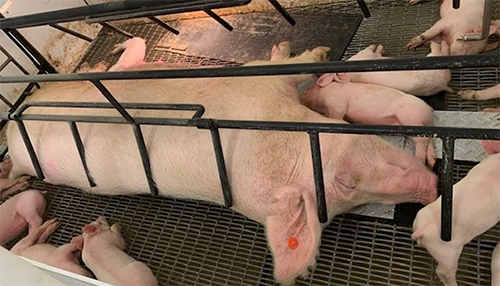
Hot Situation for Hogs
With temperatures rising because of climate change, heat stress is becoming a more serious problem for all kinds of living things — including livestock. Pigs are very sensitive to heat because they don’t sweat and therefore have trouble responding to excessive heat. This problem affects the productivity of the swine industry and causes health and welfare issues in the pig population. Currently, the United States is the third-largest producer and consumer of pork and pork products.
“You know, back around 2003, it was estimated that the swine industry lost around $299 million per year in just the U.S. alone due to heat stress,” said Jay S. Johnson, supervisory research animal scientist at the USDA-ARS Livestock Behavior Research Unit in West Lafayette, IN. “If you adjust that for inflation, that's more like $493 million per year now.”
Since then, things like climate change and genetic improvements in pig carcass and reproduction traits have resulted in pigs with greater basal level of heat generation which has culminated in lower tolerance of heat for pigs. Experiencing a heat stress event causes negative impacts on the pigs’ growth and their ability to get pregnant or to maintain a pregnancy, with greater losses commonly occurring late in the second trimester where the negative impacts on the mother and the economic losses are greater. Once exposed to heat during prenatal development, pigs also tend to grow slower, are less efficient, their immune systems are compromised, and they get more stressed during standard production procedures.
 A sow experiencing heat stress. (Photo by Jay Johnson, ARS)
A sow experiencing heat stress. (Photo by Jay Johnson, ARS)
Other common issues when growing pigs are exposed to heat stress include the amount and quality of meat, as the pigs tend to add more fat and less muscle as they grow. Because of these issues, researchers are working to understand more about how heat stress affects hogs’ behavior, productivity, and welfare. One technique the researchers are using is measuring the heat that the animal is generating and the heat they’re absorbing from the environment; that way the researchers can identify more accurately if they experienced heat stress. Another important factor is the rate of response of a pig to heat stress, and how fast their body temperature fluctuates. Some pigs demonstrate heat stress sensitivity through reductions in productivity, like a decrease in milk production in lactating sows.
In addition to external factors, researchers are investigating whether there’s a genetic difference between pigs that are more or less sensitive to heat stress. There are several projects in progress that aim to develop genomic selection models, which are a tool for enhancing molecular breeding efficiency, to breed animals that are more resilient to heat stress events.
There are common practices and tools that farmers can use to help manage their swine in heat stress events, including cooling technologies like ventilation fans and the use of natural fresh air by keeping windows unobstructed. Farmers also use drip coolers, which intermittently provide small quantities of water on the skin followed by additional cooling through evaporation, as well as evaporative cooling pad applications whereby fans distribute air cooled by passing through the wet pads.
 A sow being cooled down by a cooling pad. (Photo by Jay Johnson, ARS)
A sow being cooled down by a cooling pad. (Photo by Jay Johnson, ARS)
ARS researchers in collaboration with Purdue University and University of Illinois have developed a smartphone app called HotHog. It works as a decision support tool that alerts producers when their pigs are going to be impacted by heat stress, while offering general guidelines on different mitigation practices they can use to help get those animals over the heat stress event.
“We have animal geneticists, reproductive physiologists, nutritionists, behavior experts, basically everyone we can get together to try to solve this issue,” explained Johnson. “And really, that's what we think it's going to take.”
Heat stress is a concerning issue in many phases of swine production. When the pigs are stressed, they grow less efficiently, meaning they take longer to reach a market weight where they harvested for human consumption. As a result, farmers face increased costs associated with added feed, labor, and housing needs, while also increasing the volume of manure generated. Current ARS research strives to diminish the effects and causes of heat stress to enable more efficient production while promoting the welfare of the animals. — By Olga Vicente, ARS Office of Communications.
